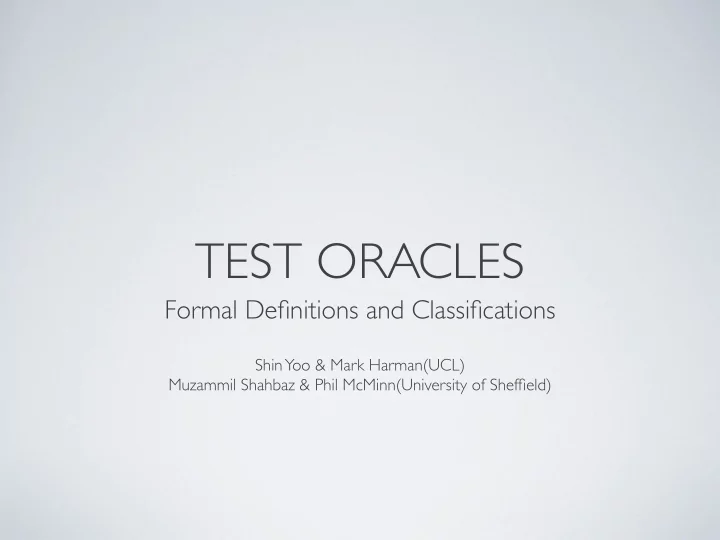

TEST ORACLES Formal Definitions and Classifications Shin Yoo & Mark Harman(UCL) Muzammil Shahbaz & Phil McMinn(University of Sheffield)
OVERVIEW • Formal Definitions • Oracle Literature Timeline & Classification
FORMAL DEFINITIONS • Few attempts to form an universal framework • Recent work on formalising testing process (Staats et al. 2011) but with different focus
Definition 1 (Alphabet) The input to the program under test will be considered to be drawn from a set I , while the output will be drawn from a set O .
Definition 2 (Test Case) A test case is a pair ( i, o ) in I × 2 O such that o is non- empty and is singleton in the case that the system, is deterministic for input i . Definition 3 (Test Instance) A test instance is a element of the set I × O
VERSION 0.1 • Define oracle as a set of test cases that establishes acceptable behavioural relationship between input and output I × O → { 0 , 1 }
VERSION 0.2 • We want to cater for probabilistic decision on acceptance I × O → [0 , 1]
INEXACTNESS Exact 0.54% 7.58% Algorithmic Methodologies for Ultra-efficient Inexact Architectures for Sustaining Technology Scaling Lingamneni et al., ACM Computing Frontiers 2012
VERSION 0.3 • We want to cater for metamorphic relations • Acceptable behaviour is defined as a relation to other test instances I × O × 2 I × O → [0 , 1]
METAMORPHIC RELATIONSHIP • If certain relation holds between two inputs, you expect a specific relation to hold between corresponding outputs x 0 = π − x → sin x 0 = sin x • Example: • Traditional examples focus on two instances, but it can be generalised to n instances • Example: linearity between input/output requires 3 instances
VERSION 0.3 • We want to cater for metamorphic relations • Acceptable behaviour is defined as a relation to other test instances I × O × 2 I × O → [0 , 1]
VERSION 0.4 • We want to cater for inferred specification/regression suites • Acceptable behaviour is defined as a relation to other test instances I × O × 2 I × O → [0 , 1]
Definition 4 (Definite Oracle) A Definite Oracle is a function from test instances to { 0 , 1 } . That is, a definite oracle is an element of the set I × O × 2 O → { 0 , 1 } . Definition 5 (Probabilistic Oracle) A Probabilistic Oracle is a function from test instances to [0 , 1]. That is, a probabilistic oracle is an element of the set I × O × 2 I × O → [0 , 1].
Definition 6 (Completeness) An Oracle is compete if it is a total function.
Definition 7 (Ground Truth) The Ground Truth, G is a definite oracle. We can now define soundness of an oracle with respect to the Ground Truth, G . Definition 8 (Soundness) A Probabilistic Oracle , PO is sound i ff ⇢ [0 , 0 . 5) when G ( i, o ) = 0 PO ( i, o ) ∈ (0 . 5 , 1] when G ( i, o ) = 1
Definition 9 (Correctness) An oracle is partially correct i ff it is sound. An oracle is totally correct i ff it is sound and complete.
Classification of Oracles in the literature review • Origin: • “test oracle” coined by W. E. Howden (1978) • “a program specification, table of examples, or the programmer’s knowledge on how the program should operate” (Howden and Eichhorst, Tutorial: Software Testing and Validation Techniques, 1978) • Classification: • Specified Oracles • Derived Oracles • Implicit Oracles • No Oracles
Specified Oracles oracles that are formally specified languages / formalisms algebraic assertions / specification based specification design-by-contracts transition based model based (FSM, UML, Statecharts etc.) (B, Z, VDM etc.) ANNA / LARCH Model Checking Spec. Languages Temporal Logic IOCO Theory H Statecharts Algeb. Spec. Design-by- RESOLVE Contract Object-Z ASML LETO VDM Alloy OCL MSC UML FSM SDL JML Z 1980 1985 1990 1995 2000 2005 2010
Derived Oracles oracles that can be derived from the given artefacts system executions existing knowledge documentations (traces, log files, invariants, ...) (partial / pseudo oracles, (source code, comments, regression, ...) APIs, specs, ...) invariant detection Metamorphic Tests Regression Testing Semi-formal docs Code Comments Log File Analysis Pseudo-Oracle Partial Oracle Mutant based N-Versions API Docs Inference 1980 1985 1990 1995 2000 2005 2010
Implicit Oracles oracles which do not require specification anomalies exceptions errors (deadlock, livelock) (crash, ...) (divide-by-zero, memory leaks, ...) Deadlock/ Livelock Anomaly detection Specific problems Model Checking JCrasher pre-1980 1985 1990 1995 2000 2005 2010
No Oracles no way of automatic validation!!! Test Size Reduction Realistic Test Data Machine Learning Usage Mining 1980 1985 1990 1995 2000 2005 2010
http://recost.group.shef.ac.uk
Recommend
More recommend